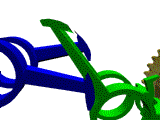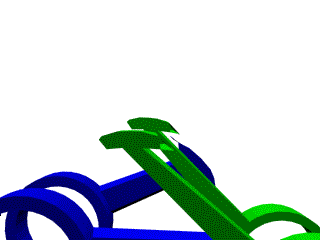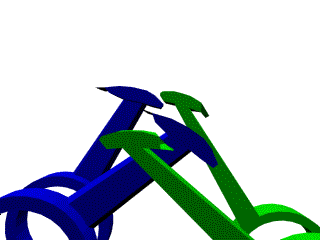
| < Previous | Up ^ | Next > |
There is one further operation that needs to be carried out. Carries may create further carries. If you add 1 to 9999 you will have all those 9's turning into 0's until the next higher significant digit tuns into a 1.
The carry mechanism as shown so far, has not shown what happens with carries produced by carries, that is, secondary carries.

The image above is a close-up of the carry drive arms (in blue) and the arms of the carry levers that is pushed by the carry drive.
Notice that the carry drive arms are at an angle from each other. Actually, the whole stack of 30 carry drive arms are staggered in a helix so that when the whole assembly turns, the carry drive arm at the bottom hits the carry lever first, followed by the successive drive arms.
Lets assume that the three less significant figure wheels hold 999 and 1 is added. The units figure wheel will go from 9 to 0 in the adding phase and the outer decade nib would push the carry lever to the warned position. The next two figure wheels still hold their nines. When the carry drive arm starts turning, the lowest arm will push the carry lever which is warned which will push the tens figure wheel from 9 to 0. The curved arm of the next carry lever will then be pushed by the decade nib of the tens figure wheel, moving the carry lever to the warned position. Immediately after, the corresponding carry drive arm which is delayed from the first, due to the angle in between them, will push this carry lever, turning the hundreds figure wheel from 9 to 0 creating a new carry that the hundreds carry lever will detect and the carry drive will propagate to the thousands.
Notice in the animation, how the bottom carry lever, which is in the 'unwarned' position, when pushed by the bottom figure wheel moving from 9 to 0, turns to the 'warned' position and exposes the arm to the carry drive arm. In this case, there is a carry from the bottom wheel to the next, but there is none from the top carry lever, which remains in the 'unwarned' position. So, when the drive arm starts turning, it hits the bottom carry arm which has stepped out of its rest position, but the next carry drive arm up misses its corresponding carry lever arm, which has remained in its rest position.
 |
The position of the carry arms and carry drive arms can be seen more clearly on these static images. The left image is before the carry drive starts turning. The bottom carry lever is at the 'warned' position, right in the way of the carry drive arm, while the top carry lever is in the 'unwarned' position, so it remains out of the way. |
 |
Now, the carry drive has just started to spin and the bottom carry arm has already pushed the carry lever arm aside (towards the right) while the upper carry drive arm is just passing by the upper carry lever arm without touching it. |
| < Previous | Up ^ | Next > |